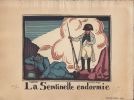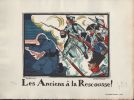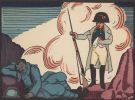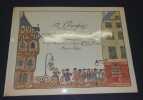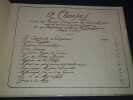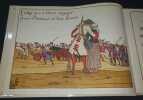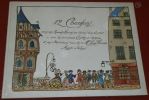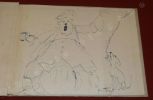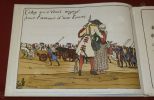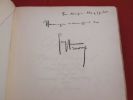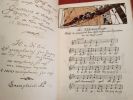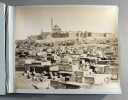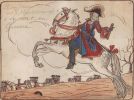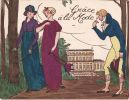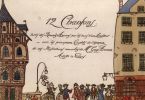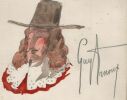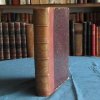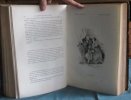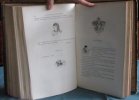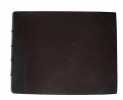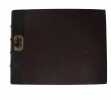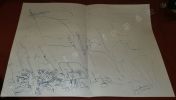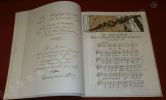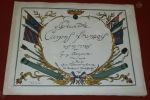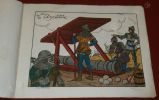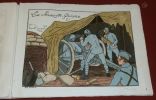1222 books for « arnoux »Edit
-
Type
Art print (5)
Book (1214)
Magazine (1)
Music sheets (1)
Photographs (1)
-
Latest
Last 3 days (2)
Last month (5)
Last week (1)
-
Language
French (1221)
Russian (1)
-
Century
16th (1)
17th (1)
19th (34)
20th (624)
21st (14)
-
Countries
Belgium (33)
Canada (1)
Denmark (2)
France (1133)
Germany (4)
Greece (1)
Italy (1)
Netherlands (1)
Switzerland (45)
United States of America (1)
-
Syndicate
CNE (1)
ILAB (528)
NVVA (4)
SLACES (3)
SLAM (511)
SNCAO (7)
Topics
- Advertisement (4)
- Alps (3)
- Ampelography - wines (7)
- Architecture (4)
- Arnoux guy (42)
- Arnoux jacques d (12)
- Arnoux jules (19)
- Autographs (19)
- Aviation (7)
- Berry (5)
- Bertall (26)
- Bibliophilism (10)
- Biography (8)
- Bordeaux (5)
- Botany (4)
- Brittany (4)
- Children’s books (17)
- Cinema (5)
- Cocteau jean (4)
- Comic strip (20)
- Cooking (3)
- Dance & ballet (5)
- Dansel michel (4)
- Daragnes (4)
- Dedication (8)
- Drawings (8)
- Early printed books (5)
- Education (4)
- Engravings (11)
- Etchings (3)
- Fine arts (3)
- First edition (54)
- Folklore (4)
- Franche comte (6)
- French literature (11)
- From lyons (4)
- Galanis (9)
- Gard (5)
- Geography (12)
- Germany (4)
- Guitry sacha (6)
- History (37)
- Ile de france (9)
- Illustrated books (12)
- Jacob (4)
- Legends (6)
- Linnean society of lyons (8)
- Literature (232)
- Lyons and area (8)
- Lyons college (8)
- Lyons college pc (8)
- Lyons revue (8)
- Mac orlan pierre (4)
- Manuscripts (7)
- Maurois andré (7)
- Mérimée prosper (4)
- Middle ages (5)
- Military arts (11)
- Modern comic (10)
- Montherlant henry de (5)
- Music (6)
- Navy (19)
- Newspapers press (12)
- Oenology (8)
- Opera ballet (4)
- Painting (4)
- Paris (32)
- Philosophy (10)
- Photography (9)
- Poetry (22)
- Poilus (5)
- Provence (16)
- Regionalism (12)
- Religions (7)
- Reliure (5)
- Review (17)
- Reviews (11)
- Rostand edmond (8)
- Saint saëns (5)
- Sem (5)
- Shapes & colours (5)
- Songs (16)
- Theatre (31)
- Travel (8)
- Various (10)
- War (34)
- War 14/18 (10)
- Woods & woods’ price lists (7)
Les Caractères observés par un vieux Philosophe du haut de sa Fenêtre et mis en 12 images par Guy Arnoux
Paris Devambez 0 In-4 à l'italienne Cartonnage toilé éditeur
EDITION ORIGINALE de ces 12 portraits littéraires illustrés de 12 compositions en couleurs au pochoir de Guy ARNOUX. L'artiste a également composé la large composition pour le titre. Tirage à 500 exemplaires numérotés. Un des 475 sur beau papier vergé Ingres d'Arches. Le cartonnage couvert de toile à motif floral et pièce de titre est très bien conservé. >Bel exempaire Très bon 0
La Baïonnette, 2è série, N°114, Les Sammies.
Tinesse. 6 septambre 1917. In-4. Broché. Bon état, Couv. convenable, Dos satisfaisant, Déchirures. 16 pages, dessins en noir et blanc et en couleurs in et hors texte. Une gravure double en couleurs. 1ère et dernière pages en couleurs par Arnoux. Couverture un peu déchirée.. . . . Classification Dewey : 70.441-Journaux satiriques anciens
L'espion par Arnoux, En souvenir du Lusitania par Arnoux, Le bon Sam et le méchant petit guillaume par Howard, Lafayette et Washington par Arnoux, La lutte des deux aigles par Howard, Tenez bon! par Arnoux, Sale affaire! par Arnoux. Classification Dewey : 70.441-Journaux satiriques anciens
Quatre images allégoriques de Guy ARNOUX.
DEVAMBEZ 1918 1 Paris, Devambez, (1918), en feuilles, sous chemise violine imprimée, quatre planches.
Exemplaire justifié 100 d'un tirage de 300 . Quatre planches coloriées au pochoir et contresignées par l'artiste représentant "Les Anciens à la Rescousse ! ", "La Sentinelle endormie", "La Vision du Dragon", "Le Vainqueur de Lorraine". Quand l'armée Napoléonienne vient à la rescousse des poilus ou La Grande Guerre revisitée par Guy ARNOUX. "Guy Arnoux (1886-1951), Peintre de la Marine, dessinateur et coloriste prestigieux, a crée toute une imagerie française singulièrement moderne et originale, en dépit de son archaïsme voulu..." Dico solo. Couverture légèrement insolée, marques de plis, infimes déchirures, planches jaunies ou brunissures marginales.
12 chansons tirées des recueils anciens par les soins d'un amateur avec les principaux couplets de l'époque et des illustrations nouvelles de Mr Guy Arnoux , artiste à Paris .
0 Sans lieu ni date ( vers 1920) - In4 oblong , cartonnage illustré et aquarellé au 1er plat d'une composition de Guy Arnoux - 26 pages doubles montées sur onglets . 12 illustrations hors texte de Guy Arnoux lithographiées en bistre et coloriées au pochoir avec en regard le texte et la portée musicale des chansons ; tout petit accroc a la coiffe supérieure sinon trés bel exemplaire . Rare premier tirage sur papier vergé à la forme imprimé d'un seul coté sans nom d'imprimeur.
Satisfaisant
12 Chansons tirées des Recueils anciens par les soins d'un Amateur avec les principaux couplets de l'époque et des Illustrations nouvelle de Guy Arnoux, Artiste à Paris.
Paris, Devambez Editeur, sans date, 1 volume de format à l'italienne de 250xx335 mm environ, 13 feuillets doubles avec le texte et l'illustration en regard, cartonnage de l'éditeur avec premier plat illustré par Guy Arnoux. Avec un dessin original de Guy Arnoux sur la première garde. Couverture très légèrement salie, sinon bon état.
Guy Arnoux, né le 26 août 1886 à Paris 7e et mort le 5 août 1951 à Ardon (Loiret), est un artiste, illustrateur et graphiste français.Il a illustré près de quatre-vingts livres dont plusieurs grands formats d'une remarquable qualité d'impression chez Devambez (1917 : Quelques drapeaux français ; 1918 : Tambours et trompettes). À l'issue de la Guerre de 1914-18, il participe à de charmants petits livres pour les enfants : Le bon Anglais, Carnet d'un permissionnaire, Nos frères d'Amérique Entre 1912 et 1925 il collabore à la célèbre revue de mode la Gazette du Bon Ton. Merci de nous contacter à l'avance si vous souhaitez consulter une référence au sein de notre librairie.
LE BON ANGLAIS
1917 un volume broché (à cordonnet) in-douze à l'italienne (Oblong 12mo), couverture sur velin pur fil ligné et filigrané, illustrée d'un bois coloré au pochoir par Guy Arnoux, illustré de 12 bois sur velin pur fil colorés au pochoir avec une légende en français par Guy Arnoux avec le texte anglais en regard (Illustrated by Arnoux with 12 fine color pochoir woodcuts plates), sans pagination (27 pages), (circa 1917) Paris Chez Devambez Editeur,
.ouvrage d'une belle qualité comme toujours chez Devambez...petit tirage...rare et.....en bon état (good condition).
LE SOLDAT FRANCAIS DANS LES GUERRES
1916 un album, reliure pleine-toile verte cartonné illustré éditeur grand in-quarto (hard-back in-4 editor) (25 x 33,3 cm), dos muet (the spine - no title), 1er plat illustré d'un dessin en couleurs coloré au pochoir par Guy Arnoux (first cover illustrated in colours by Guy Arnoux) , tranches lisses ( edges smooth), couverture trés légèrement frottée , orné de 17 planches hors-texte en couleurs colorées au pochoir par Guy Arnoux avec leurs serpentes imprimées explicatives en français et en anglais , 38 pages, 1916 Paris Société Littéraire de France Editeur,
Edition RARE.......en trés bon état malgré le petit défaut signalé (good condition in spite of the small defect indicated).
Chansons du Marin français au temps de la Marine en Bois recueillies et illustrées par Guy Arnoux
Devambez, Paris 1918. In-4 broché (32 x 25 cm). - Edition originale, l'un des 1000 exemplaires numérotés sur vergé (n° 120).- Les onze chansons, extraites du "Gaillard d'Avant" , chansons maritimes par G. de La Landelle, sont illustrées et coloriées au pochoir par Guy Arnoux : Le Langage des marins, Le Naufragé, La Belle au Capitaine, Le retour des Marins, etc. - 50 pages calligraphiées, illustrées et coloriées au pochoir. - DEDICACE de Guy Arnoux sur la page de garde, L'illustrateur est né le 26 août 1886 à Paris et mort le 5 août 1951 à Ardon (Loiret). Il a illustré près de quatre-vingts livres dont plusieurs grands formats d'une remarquable qualité d'impression chez Devambez (1917 : Quelques drapeaux français ; 1918 : Tambours et trompettes). À l'issue de la Guerre de 1914-18, il participe à de charmants petits livres pour les enfants : Le bon Anglais, Carnet d'un permissionnaire, Nos frères d'Amérique Entre 1912 et 1925 il collabore à la célèbre revue de mode la Gazette du Bon Ton. - Minimes salissures sur la couverture superbement illustrée, intérieur très frais.-270g.C. Très bon exemplaire.
[Guy ARNOUX] - Union Nationale des Croiseurs - collectif - R. ST. L. PEVERLEY - de KERVILER - couverture illustrée de Guy ARNOUX
Reference : 49157
Gala de la Mer - 28 mars 1935 - Course-Crroisière Plymouth-Belle-Ile- Causerie de M. Marin-Marie
In-4 - couverture illustrée en couleurs par Guy ARNOUX - 18 pages, Nombreuses photographies NB, certaines PP - 1 carte de la course PLYMOUTH-BENODET - Nombreuses publicités avec photographies NB - Programme du gala - Brochure reliée par un cordon bleu - Légère salissure au 1 Plat, Sinon Ex. très frais - Rare - Réf. 49157
Marin-Marie, R ST.L. Peverley, de Kerviler, G. Arnoux, - Livraison a domicile (La Poste) ou sur simple demande en Mondial Relay.- ATTENTION: Colis recommandé uniquement sur demande (parcel recommended on request). Si vous désirez un remboursement équivalent au montant de votre achat, en cas de perte détérioration ou spoliation, demandez-nous expressément un envoi en recommandé ( if you wish a repayment equivalent to the amount of your purchase, in case of loss - deterioration or despoliation, ask us expressly for a sending recommended)- Conditions de vente : Les frais de port sont affichés à titre Indicatifs (pour un livre) Nous pouvons être amené à vous contacter pour vous signaler le surcoût du au nopmbre de livres achetés ou du poids de ceux-ci. - Conditions of sale : The shipping costs are displayed as an indication (for one book) We may need to contact you to inform you of the cost of the additional shipping depending on the weight and the number of books- Possibilité d'envoi par Mondial-Relay - Réception en boutique sur rendez-vous. Librairie G. PORCHEROT - SP.Rance - 0681233148
(composite : Luigi Fiorillo; Rafael Garzòn; Félix Bonfils ; Hippolyte Arnoux ; Frères Rubellin ; Frères Zangaki ;Christopher Oscanyan etc)
Reference : 3132
(1880)
Bel album de photographies sur l’Egypte, le Liban et la Palestine, comportant d’impressionnantes photographies de momies prises au moment de leur découverte (Ramses II, Setie Ier)
Circa 1870-1880. Album in plano (30,5 x 24,5cm) composé de 52 feuilles cartonnées. Pleine percaline noire d’époque, muette, tranches dorées. Rares rousseurs, quelques photos au contraste faible, une photo avec une légère déchirure en marge, sinon très bon état de conservation. L’album est composé de soixante photos, la plupart de grand format (24 x17 cm).
Une partie des photos sont signées dans les plaques : Fiorillo (Luigi Fiorillo, 1847-1898), photographe italien installé à Alexandrie.D’autres Garzòn (Rafael Garzòn), Bonfils (Félix Bonfils, 1831-1885), Hippolyte Arnoux, Frères Rubellin (photographes installés à Smyrne). 10 photos de l’Alhambra par Garzòn, 2 photos identifiées de Rubellin (tampons au verso). Vues du Caire, très belles photos de momies, photos du port de Beyrouth, de Port-Saïd, très belles photos des pyramides, photos animées ou posées de personnages de la rue, etc. Voici le détail de quelques photographies remarquables : _ Alexandrie, la place du Consuls, photographie animée, signée Fiorillo (Luigi Fiorillo, 1847-1898), photographe italien installé à Alexandrie.- un portrait en pied du souverain d’Egypte, anonyme - Belle vue du Caire, signée Bonfils (Félix Bonfils, 1831-1885),- Très belle vue du vieux Caire, signée Zangaki (les frères Zangaki)- Vue générale des tombeaux des Mameluks- Mosquée Hassan Pacha- Les bords du Nil, signée Fiorillo- La cours du musée Boulak, signée Fiorillo- Très Belle photographie en pied de la momie de Sethi Ier, fils de Ramsès I, 1881Découverte en 1881, et photographiée pour la première fois sous l’autorité de Maspero- Portrait en buste de la momie de RAMSES II, 1881Attribué à Félix Bonfils- Photographie de facies de momie anonyme, reproduite sur le site du Musée d’Orsay décrite comme, « Anonyme, momie, vers 1850, Epreuve sur papier albuminé à partir d’un négatif. », Cette photographie nous paraît plutôt contemporaine des deux précédentes c’est à dire circa 1880. - Deux photographies sur papier albuminé, « statue de bois » et « sarcophage ». - « Arles, musée Lapidaire frise de l’arc de triomphe » - «Le prince Rahotep et la dame Nefertiti », Anonyme - « Le Caire, la grande pyramide de Cheops ( sic) », Anonyme - « Pyramide de Cheops, les sphinx ensablés », Hippolyte Arnoux- Personnages disposés sur les pierres de la grande pyramide, signée Zangaki- « Port Saïd, groupe de baudets », Hippolyte Arnoux- scène de genre, femme voilée portant une potiche sur la tête, anonyme - scène de genre, les petits métiers de Caire, anonyme - Belle «Vue de port Saïd », Hippolyte Arnoux, circa 1880- « Jaffa, vue générale prise de la mer. Palestine », signée Bonfils- « Vue de la ville de Haïfa, Palestine » , signée Bonfils- « Vue générale de Beyrouth, et du Mt Liban, Syrie » , signée Bonfils- 3 vues anonymes de Beyrouth et du mont Liban, timbre humide sur l’une d’entre elles, de l’établissement « Rubellin, Photographie parisienne à Smyrne »- vue d’un pont avec Chameaux, timbre humide « photographie parisienne », anonyme - Vue d’un cimetière avec des cèdres en arrière plan, signature estampée illisible - Vue du Port de Galata, Constantinople, 1876, Christopher Oscanyan- Autre vue de Constantinople - Vue de l’entrée d’une Mosquée (Sebah ?) - Vue de la grande mosquée de Constantinople, anonyme, - 8 photographies probablement du Liban - Lyra ( ?) Grèce, Signé Bonfils - 10 photographies Grenade, Alhambra, vues de villes et bâtiments, signé Garzon,
TERRES DE DÉBAT. Illustrations de Guy Arnoux
Paris Editions Littéraires de France 1945 petit in 4 (24,5x19,5) 1 volume broché, couverture illustrée rempliée, 154 pages [2], avec de nombreuses illustrations en couleurs de Guy Arnoux, dont 14 hors-texte, 25 illustrations en couleurs in-texte, 10 bandeaux en couleurs, 10 culs-de-lampe en couleurs. Coloris au pochoir. Guy Arnoux, 1886-1951. Tirage limité à 1010 exemplaires, celui-ci un des 935 exemplaires numérotés de 1 à 935. Bel exemplaire ( Photographies sur demande / We can send pictures of this book on simple request )
Très bon Ed. numérotée
"Monsieur de Marlborought-12 chansons".
Paris Martine 1920 Aquarelle et encre signée en bas à gauche, (1920), 23.5 x 31 cm. Joint l'ouvrage 12 chansons tirées des recueils anciens par les soins d'un amateur avec les principaux couplets de l'époque et des illustrations nouvelles de M. Guy Arnoux, artiste à Paris. Paris, Martine, (1920), in-4 oblong, demi-toile beige, couverture cartonnée, plat supérieur lithographié et colorié au pochoir, (26) feuilles.
Maquette originale de Guy ARNOUX illustrant la chanson "Malborrough s'en va-t'en Guerre" pour le recueil de 12 chansons édité à titre publicitaire par la maison Paul POIRET pour Martine et illustré au pochoir par Guy ARNOUX. Pour chacune des chansons les notes de musique sont autographiées et les paroles imprimées, en regard une superbe illustration en pleine page de Guy ARNOUX. Citons : Cadet Rousselle, Il était un petit navire, Frère Jacques, Fanfan-La Tulipe, Compère Guilleri, "Malborought s'en va-t'en Guerre", Grâce à la mode (illustré de deux mannequins de la Maison Poiret sur fond de son Hôtel Faubourg Saint Honoré). Nous joignons l'ouvrage. Annotations manuscites de l'artiste, à la mine de plomb au recto du dessin : "Monsieur de Marlborought s'en va-t-en Guerre" et portant le numéro "10". Au verso annotations manuscrites à la mine de plomb. Quelques piqures sur le dessin.
Terres de débat.
1945 Illustrations de Guy Arnoux. Paris, Éditions Littéraires de France, 1945, petit volume in-4, broché, sous couverture rempliée illustrée en couleurs, sous chemise et étui rouge cartonné, titre en long sur le dos noir, 154 pages.
Ouvrage illustré de 13 illustrations en couleurs hors-texte de Guy Arnoux, la couverture, le frontispice 25 illustrations en couleurs in-texte, 10 bandeaux et 10 culs-de-lampes, tous coloriés au pochoir. Bel envoi de Guy Arnoux accompagné d'un dessin original sur le faux-titre. Manque à l'étui (dos) détaché, usures à la chemise, brochage fragile. Tirage limité à 1010 exemplaires numérotés. Intérieur frais. Monod, 2313. Guy Arnoux (1886-1951), peintre de la Marine, dessinateur et coloriste prestigieux, "a crée toute une imagerie française singulièrement moderne et originale, en dépit de son archaïsme voulu..." (Dico Solo).
Images de Paris.
Paris, Editions Lambert-Marie, 1948; petit in-4, br. Atelier Paul Haasen , Editions Lambert-Marie, 1948. souple. Présentés par Alexandre Arnoux, un des 1000exemplaires numérotés n°38, 1 vol. grand in-8 en feuillet sous chemise rempliée illustrée, Atelier Paul Haasen, Editions Lambert-Marie, s.d. (1948), avec 12 gravures sous passepartout : Ile Saint-Louis - Notre-Dame - Place de la Concorde - Place de l'Opéra - Place Vendôme - Place Pigalle - Les Tuileries - Place Contrescarpe - Saint-Germain-des-Prés - Les Invalides - La Tour Eiffel - Les Champs-Elysées. Envoi de Michel Béret. Un des 15 exemplaires H. C. numérotés réservés à l'artiste. Très bel exemplaire. Comme l'écrit Alexandre Arnoux, ces douze burins "possèdent une certitude aiguë et un charme précis ; par un assez étrange paradoxe ils forment une suite, très volontairement composée, poussée jusqu'à l'abstraction, et d'où se dégage sans que je sache pourquoi ni comment, une poésie qui s'empare de moi à mon insu, une sensibilité vaporeuse qui correspond magiquement au souvenir de ma ville". Un véritable album de "cartes postales exquisement choisies, à l'aide desquelles on peut rebâtir Paris dans sa plus irréelle exactitude, dans ses stylisations les plus vraies. Ces cartes postales-là, je les retirerai chaque soir de ma valise, je m'imaginerai que la colonne Vendôme en personne m'a adressé son élancement et son coeur percé d'une flèche, la place de la Concorde, sa sirène, la Tour Eiffel, son feu d'artifice, Saint-Germain-des-Près, son clocher roman, les Champs-Elysées, leurs chevaux de pierre, les arbres de l'Ile Saint-Louis, leur remorqueur et leur pêcheur à la ligne." Langue: Français - planches en très bon état chemise un peu usagé une dédicace pleine page cadeau.
Atelier Paul Haasen , Editions Lambert-Marie, 1948. souple. Présentés par Alexandre Arnoux, un des 1000exemplaires numérotés n°38, 1 vol. grand in-8 en feuillet sous chemise rempliée illustrée, Atelier Paul Haasen, Editions Lambert-Marie, s.d. (1948), avec 12 gravures sous passepartout : Ile Saint-Louis - Notre-Dame - Place de la Concorde - Place de l'Opéra - Place Vendôme - Place Pigalle - Les Tuileries - Place Contrescarpe - Saint-Germain-des-Prés - Les Invalides - La Tour Eiffel - Les Champs-Elysées. Envoi de Michel Béret. Un des 15 exemplaires H. C. numérotés réservés à l'artiste. Très bel exemplaire. Comme l'écrit Alexandre Arnoux, ces douze burins "possèdent une certitude aiguë et un charme précis ; par un assez étrange paradoxe ils forment une suite, très volontairement composée, poussée jusqu'à l'abstraction, et d'où se dégage sans que je sache pourquoi ni comment, une poésie qui s'empare de moi à mon insu, une sensibilité vaporeuse qui correspond magiquement au souvenir de ma ville". Un véritable album de "cartes postales exquisement choisies, à l'aide desquelles on peut rebâtir Paris dans sa plus irréelle exactitude, dans ses stylisations les plus vraies. Ces cartes postales-là, je les retirerai chaque soir de ma valise, je m'imaginerai que la colonne Vendôme en personne m'a adressé son élancement et son coeur percé d'une flèche, la place de la Concorde, sa sirène, la Tour Eiffel, son feu d'artifice, Saint-Germain-des-Près, son clocher roman, les Champs-Elysées, leurs chevaux de pierre, les arbres de l'Ile Saint-Louis, leur remorqueur et leur pêcheur à la ligne." Langue: Français - planches en très bon état chemise un peu usagé une dédicace pleine page cadeau.
[BERTALL (Charles Albert d'Arnoux)] - BERTALL (Charles Albert d'Arnoux)
Reference : 18147
(1874)
La Comédie de notre Temps - Édition originale.
La Civilité - Les Habitudes - Les Moeurs - Les Coutumes - Les Manières et les Manies de notre Époque. Études au crayon et à la plume par Bertall.Édition originale. Paris, Plon - 1874 - 651 pages.Reliure demi-chagrin havane de l'époque. Dos à nerfs orné et doré. Pas de rousseur. Reliure et plats frottés. Très bon état intérieur. Format in-4°(28x20).Charles Constant Albert Nicolas d'Arnoux de Limoges Saint-Saëns dit Bertall, né le 18 décembre 1820 à Paris et mort le 24 mars 1882 à Soyons, est un illustrateur, caricaturiste et graveur français. Connu également sous le nom Tortu-Goth, il est considéré comme l'un des illustrateurs les plus féconds du XIXe siècle et compte parmi les pionniers de la photographie.
BERTALL (Charles Albert d'Arnoux)
"THOMSON, JOHN (+) WILLIAM FLOYD (+) FELICE BEATO (+) HIPPOLYTE ARNOUX.
Reference : 60283
(1872)
The Tordenskjold-expedition. 71 albumen prints from the 1860'ies to 1873. - [FINE COLLECTION OF EARLY PHOTOGRAPHS FROM EAST-ASIA DOCUMENTING THE LAYDOWN OF THE FIRST TELEGRAPH CABLES IN EAST-ASIA]
1870-1872. Folio-oblong (395 x 320 mm). Original brown half calf, recased - the original cloth (with gilt lettering to the front) has been expertly mounted on to the new boards, and most of the original gilt leather spine has been preserved over a perfectly matching new lovely brown half calf. ""Tordenskjold / 1870 - 1873"" in gilt lettering, partly worn of, to front board. End-papers renewed. 71 albumen print in various sizes and by various photographers (see below) mounted on 59 contemporary white cardboard leaves (measuring 370 x 310 mm), all re-hinged. The album was water-damaged at some point, but has been expertly and neatly restored and appears in overall very good condition with good tones. 1, Oval photo of Tordenskjold (205 x 60mm) 2, Photo of Tordenskjold (190 x 143 mm) 3, Crew aboard Tordenskjold (200 x 14 mm) 4, Crew aboard Tordenskjold (157 x 128 mm) 5, Crew and equipment aboard Tordenskjold (228 x 176 mm) 6, Naval officers about Tordenskjold (167 x 130 mm). 7, 8 small photos of various places on one plate (274 x 190 mm) 8, The harbor of Port Said. By Hippolyte Arnoux (247 x 190mm) 9, Muddigging machines in the channel of Port Said. By Hippolyte Arnoux. (245 x 190mm) 10, Port Said. By Hippolyte Arnoux. 11, Malta (262 x 207 mm) 12, Two photos of Malta (each measuring 134 x 120 mm) 13, Two photos of Gibraltar (Each measuring 148 x 114) 14, Deep Water Bay, Hong Kong (194 x 130 mm). 15, Two photos depicting telegraph-house and ships in Deep Water Bay (each measuring 150 x 112) 16, Boat with people. By Felice Beato, coloured (294 x 235 mm) 17, House next to river. By John Thomson, December 1870 (278 x 225 mm) 17, Seamen’s hospital in Hong Kong. (261 x 190 mm) 18, Hong Kong. (270 x 195 mm) 19, Hong Kong, by Floyd (270 x 192 mm) 20, Hong Kong, by Floyd (240 x 190 mm) 21, Two photos of sites in Hong Kong (each measuring 165 x 127 mm) 22, Five Persians in Hong Kong (215 x 244 mm) 23, Group of women in Hong Kong, (326 x 215 mm) 24, Two photos of Hong Kong harbour, one photo depicting “Cella” (182 x 105" 130 x 98 mm) 25, Villa at Canton. (264 x 190 mm) 26, Pagode in Xuexiu Park, Guangdong. By William Pryor Floyd. (195 x 246 mm) 27, Boats in Canton. William Pryor Floyd,(270 x 223 mm) 28, Pou-Ting-Qua’s Garden, Canton. By John Thomson. (289 x 230 mm) 29, Fields in Canton. (205 x 155 mm) 30, Houses in Canton. (267 x 210 mm) 31, Canton harbor. By John Thomson. (245 x 202 mm) 32, Boat on the Canton river. (274 x 204 mm) 33, Wall around Canton. (260 x 200 mm). 34, Boats in Canton (293 x 225) 35, Telegraphstation in Woosung. (150 x 110 mm) 36, Boats in Foochow. (287 x 232 mm) 37, Temple in Foochow. By John Thomson (190 x 237 mm) 38, Pagode in Foochow. Presumably by John Thomson. (287 x 220 mm). 39, Tomb of Fou Tcheou. By John Thomson. (290 x 225 mm). 40, Temple in Shanghai. (237 x 188 mm). 41, Shanghai. (232 x 176 mm) 42, Chaochow bridge, Kwangtung. By John Thomson. (266 x 204 mm). 43. Panorama of Nagasaki consisting of two photos. (371 x142 mm) 44, Two photos of Nagasaki. Felice Beato. (Each measuring 169 x 119 mm). 45, Two photos from Nagasaki. Presumably by Felice Beato. (Each measuring 165 x 118 mm) 46, Two photos from Nagasaki. Presumably by Felice Beato. (Each measuring 165 x 118 mm) 47, Temple in Nagasaki. Presumably by Felice Beato. (169 x 118 mm). 48, Photo of Japanese woman in kimono. By Felice Beato. (205 x 255 mm). 49, Two photos of officers in house in Yokohama. (162 x 125 mm). 50, The Abbot and Monks of Kushan Monastery. By John Thomson. (287 x 204 mm). 51, Wooden structure, presumably Nagasaki. Presumably by Felice Beato. (270 x 208 mm) 52, Pagode, presumably Nagasaki. Presumably by Felice Beato. (234 x 185 mm) 53, Cityscape with lake, presumably Nagasaki. Presumably by Felice Beato.. (280 x 228 mm). 54, Two photos, cemetery and stairs to temple. By Felice Beato. (Each measuring 168 x 118 mm). 55, People standing outside house, presumably Hong Kong. By John Thomson. (185 x 155 mm) 56, Guangzhou Great Norh Gate, Canton. By John Thomson (245 x 156 mm). 57, Two photos, one of the building of a telegraph station (presumably in Wladivostok) and a view of Wladivostok from the sea (154 x 123 130 x 99 mm). 58, Seascape of two ships. (130 x 140 mm). 59, Ship laying for anchor. (170 x 123 mm)
Exceedingly rare photo-album documenting the Danish vessel Tordenskjold’s mission in laying the very first telegraph cables in East Asia thereby connecting China and Japan to the global telegraph system. The album consists of photos taken aboard the vessel Tordenskjold, of Tordenskjold itself along with its crew, by an unknown photographer, and of photographs of the visited cities and surrounding areas by some of the finest photographers operating in East Asia at the time, such as John Thomson, William Floyd, Felice Beato and, in Egypt, Hippolyte Arnoux - all photographs presumably brought home by William Lund, Captain on board Tordenskjold. Through some of the earliest photos taken in China, Japan, and of the excavation of the Suez Canal, the present album depicts a pivotal moment in international relations and communications. Submarine telegraph cables were first brought to China by Danish magnate Carl Fredrick Tietgen (1829-1901), who in 1870 set up the Great Northern China and Japan Extension Company. The company was created to build and operate a telegraph cable connecting Hong Kong, Shanghai, and Japan, continuing on to Vladivostok on Russia's East coast. From Vladivostok, a cable ran along the Trans-Siberian Railway, linking Hong Kong to telegraph networks in Britain, Europe, and America. Tietgen fought off strong competition - primarily English-, and eventually won the concession to lay and operate new telegraph cables connecting Russia, China and Japan. Tietgen and his partners had embarked upon a grand and risky project. Undersea cables would need to be laid in waters that had not been sounded, cables were to be brought ashore on coasts where the prevailing conditions were not known, and it was uncertain whether the respective governments would grant permission. Everything – cables, stations, wire, and apparatus – was to be brought from Europe and had to function as a coherent system. Two chartered English steamships ‘Cella’ and ‘Great Northern’ were to transport and lay the cables, and the propeller-driven Danish frigate ‘Tordenskjold’ was to sound the waters near Nagasaki and Vladivostok, it had to also carry a relatively small amount of cables, and it was to keep away uninvited guests (of which there were plenty in the South China Sea). “As a small nation with negligible military resources, Denmark could provide a useful – politically neutral – centre for telegraph links to major European powers such as Britain, Russia and the emerging new power of Prussia. The Danes were able to utilize the technical know-how which had been accumulated with great difficulty, and occasionally heavy economic losses, in the preceding decades by British and American entrepreneurs. The competition between the Danish and British groups of telegraph entrepreneurs for first access to the Chinese market was preliminarily resolved when the directors of the two companies negotiated a secret agreement in May 1870. The Danish group had acquired an advantage in terms of timing by winning the Russian concession in 1869, and had to cover shorter distances by sea cables from Vladivostok to Nagasaki and Shanghai. But the British group had the advantage of better access to capital and a more extensive technical experience with submarine cable manufacture and operation. The essence of the agreement was that the line between Hong Kong and Shanghai should be established and operated by the Great Northern the companies would share the income for telegrams which passed this section of the line and they would run offices in Hong Kong and Shanghai jointly. The agreement provided the Danes with assured landing rights in Hong Kong and with British diplomatic support for attempts to secure landing rights in China. Permission to bring submarine telegraph cables into Chinese treaty ports was obtained in 1870 from the Chinese Government (i.e., the office of foreign affairs, known as the Zongli Yamen) by the British Minister in Peking, Thomas Wade. At the same time, the Danish government had dispatched a diplomatic envoy, Chamberlain Julius Sick, at the Great Northern’s expense to China and Japan to obtain the necessary concessions. The cable between Hong Kong and Shanghai was laid in 1870–1871 with the assistance of the frigate Tordenskjold, which the Danish government had generously allocated to the task. The Great Northern had a great deal of technical problems with the cables they had bought from the British manufacturer since the quality of the insulation was not as good as expected. Therefore, the official opening of the line between Shanghai and Hong Kong was delayed until April 1871. During the remainder of that year the company struggled to finish cable sections from Shanghai to Nagasaki, and from Nagasaki to Vladivostok. Communication between Shanghai and Europe via these cables and the Russian Siberian lines was officially inaugurated on 1 January 1872.” (Erik Baark: Wires, Codes and People The Great Northern Telegraph Company in China 1870–90) The album covers and illustrates one on the most fascinating periods in the process of internationalization in the late modern period: The Suez Canal had just opened and ‘Tordenskjold’ was the first Danish ship to sail through it. The submarine cables linked the major hubs in East Asia to the Western world and helped facilitate an unprecedented growth in the region. Overall, the laying of the submarine cable in 1870-71 was a transformative event for East Asia in general. It played a critical role in the area's economic and social development, helping to make it the global commercial center it is today.
"ZANGAKI (+) BONFILS (+) ARNOUX (+) A. BEATO (+) FIORILLO (+) BECHARD (+) SEBAH.
Reference : 60316
(1880)
Album containing 146 albumen prints of Egypt from the 1870ies. - [MAGNIFICENT ALBUM WITH EARLY PHOTOGRAPS OF EGYPT INCLUDING SOME OF THE VERY EARLIEST OF THE SUEZ CANAL ]
Egypt, ca. 1870ies. Folio-oblong (365 x 280 mm). 146 albumen prints mounted verso and recto on 73 ff. Bound in contemporary half cloth. With traces of paper-label to inner margin of front board. Label of the stationery shop ""Maison Martinet, Albert Hautecoeur, bd des Capucines, 12, Paris"" pasted on to upper outer corner of pasted down front end-paper. Paper creased and some leaves symetrically perforated, not affecting photos. Two photos with tears and a few photos partly detached from paper. Some photos are slightly discoloured and toned but are in general in good condition.
Extraordinary collection containing 146 albumen prints depicting landscapes and animated scenes of Egypt including some of the very earliest photographs of the newly opened Suez Canal. The photographs also document a period in Egyptian history, where the country began to gain independence and autonomy from Ottoman rule" Constantinople had granted Egypt the status of an autonomous vassal state or Khedivate in 1867, and completion of the Suez Canal gave Britain a faster route to India which in turn made Egypt increasingly reliant on Britain for both military and economic aid. Most photos are signed by the greatest local photographers of the time: the Zangaki brothers, Bonfils, Arnoux, Beato, Fiorillo, Béchard and Sébah. Active in the second half of the 19th century, these photographers of diverse origins such as French, Italian, British, Ottoman and Greek all established a studio or a branch in Egypt, in Alexandria, Port Said and Cairo. The Suez Canal was one of the most ambitious engineering projects of the 19th century. It was designed to create a waterway between the Mediterranean Sea and the Red Sea, linking Europe and Asia and providing a faster and more efficient route for shipping goods between the two continents. Construction of the canal began in 1859 and took over ten years to complete. Hippolyte Arnoux is best known for his remarkable photographs of the Suez Canal in Egypt. Arnoux's photographs of the Suez Canal were groundbreaking in their time and remain an important documentation of the construction of one of the world's most significant engineering endeavors. He was hired by the French government to document the construction of the canal, and he spent several years in Egypt taking photographs of it. He used a large-format camera, which allowed him to capture incredible detail and clarity in his images. Arnoux's photographs of the Suez Canal were not only important documents of the construction of the canal, but they also played an important role in the popular imagination of the time. They helped to promote the idea of progress and modernity, as well as the importance of colonialism and European expansion in the world. Zangaki's portrait photography also received much acclaim. His portraits were known for their ability to capture the essence of his subjects, conveying their personality, character, and emotions, and his portraiture work also demonstrated his mastery of lighting, composition, and posing.Zangaki's landscape photography is another notable aspect of his work. He and his brother captured breathtaking images of Egypt's natural landscapes, such as the Nile River, the desert, and the countryside. Their images were notable for their use of contrast, shadows, and light, creating a unique atmosphere that evoked the beauty and mystery of Egypt's landscapes. Their work contributed significantly to the early days of Egyptology, as it allowed European scholars and archaeologists that were not in a position to travel to examine the monuments and artifacts. The present collection forms a fine testament to one the most interesting periods in modern Egyptian history and to the cradle of Egyptian photography.
"Roland Dorgelès Dignimont Alexandre Arnoux Bertold Mahn Georges Duhamel Gus Bofa Galtier-Boissière Mac Orlan Georges Girard Marc Stéphane Paul Chack Bernard Zimmer A. Villeboeuf Claude Blanchard Dunoyer de Segonzac Oberlé Charles Martin Luc-Albert Moreau Guy Arnoux"
Reference : 10394
(1928)
"La Guerre"
"1928. Paris Le Crapouillot août 1928 (numéro anniversaire) - Agrafé 25 cm x 32 5 cm 70 pages - Textes de Roland Dorgelès Georges Duhamel Gus Bofa Galtier-Boissière Alexandre Arnoux Mac Orlan Georges Girard Marc Stéphane Paul Chack Bernard Zimmer A. Villeboeuf Claude Blanchard ; ills noir & blanc in-texte de Dunoyer de Segonzac Oberlé Charles Martin Galtier-Boissière Dignimont Luc-Albert Moreau Bertold Mahn Guy Arnoux photos noir & blanc in-texte - Bon état"
12 CHANSONS tirées des recueils anciens, par les soins d'un Amateur; avec les principaux couplets de l'époque et des Illustrations nouvelles de Mr. Guy Arnoux, artiste à Paris.
lourdes 1910 -in-8 oblong cartonné un album, reliure bradel crème cartonné in-quarto à l'italienne Editeur (33,5 x 25,2 cm), dos muet, couverture illustrée en couleurs par GUY ARNOUX, album sur vergé est entièrement monté sur onglet. Douze chansons avec paroles et musique font face à douze magnifiques compositions au pochoir et à pleine page en Couleurs de Guy Arnoux. L'illustration de la dernière chanson représente deux jeunes femmes habillées à la mode du Directoire devant l'hôtel de Paul Poiret, avenue d'Antin. Le texte de cette chanson "grâce à la mode, on n'a plus de corset,." est ici un clin d'oeil à la mode imposée par le grand couturier, Sans lieu, vers 1910, Imprimé par Paul Dupont et édité dans les ateliers Martine de la Maison Paul Poiret Editeur,
BEL EXEMPLAIRE .....rare.....en trés bon état (very good condition). trés bon état
Quelques Drapeaux françois, Dessinés et coloriés par Guy Arnoux.
Edité par Devambez, à Paris, sans date (1917), grand in-folio de 485x330 mm environ, une chemise cartonnée illustrée avec dos toilé, fermée par un ruban tricolore, contenant 10 illustrations légendées pleine page couleurs de Guy Arnoux. Exemplaire N°16/500, un des 14 exemplaires numérotés de 12 à 25, sur papier Impérial du Japon avec un grand dessin original sur double-page et un petit dessin original au bas du justificatif de tirage. Couverture un peu salie avec petites rousseurs, intérieur bon état.
Guy Arnoux, né le 26 août 1886 à Paris 7e et mort le 5 août 1951 à Ardon (Loiret), est un artiste, illustrateur et graphiste français. Il a illustré près de quatre-vingts livres dont plusieurs grands formats d'une remarquable qualité d'impression chez Devambez (1917 : Quelques drapeaux français ; 1918 : Tambours et trompettes). À l'issue de la Guerre de 1914-18, il participe à de charmants petits livres pour les enfants : Le bon Anglais, Carnet d'un permissionnaire, Nos frères d'Amérique... Merci de nous contacter à l'avance si vous souhaitez consulter une référence au sein de notre librairie.
Tambours et Trompettes, Images de Guy Arnoux.
Edité par Devambez, à Paris, sans date (1918), grand in-folio de 485x330 mm environ, une chemise cartonnée illustrée avec dos toilé, fermée par un ruban tricolore, contenant 10 illustrations légendées pleine page couleurs de Guy Arnoux. Exemplaire N°64/500, un des 475 exemplaires numérotés de 26 à 500, sur papier Ingres avec un dessin original sur le premier contreplat. Couverture un peu salie avec petites rousseurs, intérieur bon état.
Guy Arnoux, né le 26 août 1886 à Paris 7e et mort le 5 août 1951 à Ardon (Loiret), est un artiste, illustrateur et graphiste français. Il a illustré près de quatre-vingts livres dont plusieurs grands formats d'une remarquable qualité d'impression chez Devambez (1917 : Quelques drapeaux français ; 1918 : Tambours et trompettes). À l'issue de la Guerre de 1914-18, il participe à de charmants petits livres pour les enfants : Le bon Anglais, Carnet d'un permissionnaire, Nos frères d'Amérique... Merci de nous contacter à l'avance si vous souhaitez consulter une référence au sein de notre librairie.
Chansons du Marin Français au temps de la Marine en Bois, recueillis et illustrées par Guy Arnoux.
Paris, Devambez Editeur, 1918, 1 volume de 320x250 mm environ, non paginé (24 feuillets), chansons extraites du "Gaillard d'Avant" , chansons maritimes par G. de La Landelle (E. Dentu, Editeur), broché sous couverture rempliée illustrée. Exemplaire N° 899/1125, un des 1000 exemplaires sur Vergé, avec une dédicace et un dessin original de Guy Arnoux sur la première garde. Couverture très légèrement salie avec petites rousseurs sur les bordures, sinon bon état.
Guy Arnoux, né le 26 août 1886 à Paris 7e et mort le 5 août 1951 à Ardon (Loiret), est un artiste, illustrateur et graphiste français.Il a illustré près de quatre-vingts livres dont plusieurs grands formats d'une remarquable qualité d'impression chez Devambez (1917 : Quelques drapeaux français ; 1918 : Tambours et trompettes). À l'issue de la Guerre de 1914-18, il participe à de charmants petits livres pour les enfants : Le bon Anglais, Carnet d'un permissionnaire, Nos frères d'Amérique Entre 1912 et 1925 il collabore à la célèbre revue de mode la Gazette du Bon Ton. Merci de nous contacter à l'avance si vous souhaitez consulter une référence au sein de notre librairie.
Quatre Canons françois mis en images par Guy Arnoux
Paris, Devambez. Imp. sans date, 1 chemise de format à l'italienne de 275x365 mm environ, contenant 4 images légendées de Guy Arnoux, dans une chemise illustrée par le même. Tiré à 500 exemplaires. Bordures légèrement insolées avec petites rousseurs, sinon Bon état.
Guy Arnoux, né le 26 août 1886 à Paris 7e et mort le 5 août 1951 à Ardon (Loiret), est un artiste, illustrateur et graphiste français.Il a illustré près de quatre-vingts livres dont plusieurs grands formats d'une remarquable qualité d'impression chez Devambez (1917 : Quelques drapeaux français ; 1918 : Tambours et trompettes). À l'issue de la Guerre de 1914-18, il participe à de charmants petits livres pour les enfants : Le bon Anglais, Carnet d'un permissionnaire, Nos frères d'Amérique Entre 1912 et 1925 il collabore à la célèbre revue de mode la Gazette du Bon Ton. Merci de nous contacter à l'avance si vous souhaitez consulter une référence au sein de notre librairie.
Les Jeunes Héros de France, Quatre images de Guy Arnoux.
Paris, Devambez. Imp. sans date, 1 fascicule de 330x235 mm environ, contenant 4 images légendées avec remarques de Guy Arnoux, dans une chemise illustrée par le même. Tirage à 10 exemplaires avec 1 remarque (tirage normal à 500 ex). Bon état.
Guy Arnoux, né le 26 août 1886 à Paris 7e et mort le 5 août 1951 à Ardon (Loiret), est un artiste, illustrateur et graphiste français.Il a illustré près de quatre-vingts livres dont plusieurs grands formats d'une remarquable qualité d'impression chez Devambez (1917 : Quelques drapeaux français ; 1918 : Tambours et trompettes). À l'issue de la Guerre de 1914-18, il participe à de charmants petits livres pour les enfants : Le bon Anglais, Carnet d'un permissionnaire, Nos frères d'Amérique Entre 1912 et 1925 il collabore à la célèbre revue de mode la Gazette du Bon Ton. Merci de nous contacter à l'avance si vous souhaitez consulter une référence au sein de notre librairie.
A la Gloire des Soldats Suisses (Hommage francais).
Paris, Société Littéraire de France, 1917, 1 chemise cartonnée avec dos toilé et une grande vignette de titre sur le premier plat et fermée par 3 paires de liens, contenant 13 feuillets légendés illustrés par Guy Arnoux, avec un dessin original de Guy Arnoux sur le premier contreplat. Exemplaire N° 73/350, un des 325 sur papier d'Arches, numérotés de 26 à 350. Bon état.
Guy Arnoux, né le 26 août 1886 à Paris 7e et mort le 5 août 1951 à Ardon (Loiret), est un artiste, illustrateur et graphiste français.Il a illustré près de quatre-vingts livres dont plusieurs grands formats d'une remarquable qualité d'impression chez Devambez (1917 : Quelques drapeaux français ; 1918 : Tambours et trompettes). À l'issue de la Guerre de 1914-18, il participe à de charmants petits livres pour les enfants : Le bon Anglais, Carnet d'un permissionnaire, Nos frères d'Amérique Entre 1912 et 1925 il collabore à la célèbre revue de mode la Gazette du Bon Ton. Merci de nous contacter à l'avance si vous souhaitez consulter une référence au sein de notre librairie.
 Write to the booksellers
Write to the booksellers

